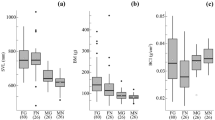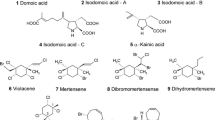Abstract
Materials eliciting increased tongue flicking and prey attack in garter snakes were isolated from both earthworm and fish prey. New extraction methods based on chloroform-methanol mixtures are valuable adjuncts to the more typical aqueous preparations. Both high- and low-molecular weight components from earthworms and fish were active. The similarity between the active chemicals in these two classes of prey was established using several methods of analysis. These included chromatography, carbohydrate and amino acid analyses, and nuclear magnetic resonance.
Similar content being viewed by others
References
Adams, E. 1978. Invertebrate collagens.Science 202:591–598.
Arnold, S.J. 1981. The microevolution of feeding behavior, pp. 409–453,in A. Kamil and T. Sargent (eds.). Foraging Behavior: Ecological, Ethological, and Psychological Approaches. Garland STPM, New York
Blight, E.G., andDyer, W.J. 1959. A rapid method of total lipid extraction and purification.Can. J. Biochem. 37:911–917.
Burghardt, G.M. 1969. Comparative prey-attack studies in newborn garter snakes of the genusThamnophis.Behaviour 33:77–114.
Burghardt, G.M. 1970. Chemical perception in reptiles, pp. 241–308,in J.W. Johnston, Jr., D.G. Moulton, and A. Turk (eds.). Communication by Chemical Signals. Appleton-Century-Crofts, New York.
Burghardt, G.M. 1980. Behavioral and stimulus correlates of vomeronasal functioning in reptiles: Feeding, grouping, sex, and tongue use, pp. 275–301,in Müller-Schwarze and R.M. Silverstein (eds.). Chemical Signals in Vertebrates and Aquatic Invertebrates. Plenum, New York.
Carpenter, C.C. 1952. Comparative ecology of the common garter snake (Thamnophis sirtalis), the ribbon snake (Thamnophis sauritus), and Butler's garter snake (Thamnophis butleri).Ecol. Monogr. 22:235–258.
Drummond, H. 1983. Aquatic foraging in garter snakes: A comparison of specialists and generalists.Behaviour 86:1–30.
Gordon, A., andRichard, F. 1972. The Chemist's Companion. John Wiley & Sons, New York.
Halpern, M., andKubie, J. 1984. The role of the ophidian vomeronasal system in species-typical behavior.Trends Neurosi. 7:472–477.
Halpern, M., Schulman, W., Scriabni, L., andKirschenbaum, D.M. 1984. Characterization of vomeronasally-mediated response eliciting components of earthworm wash-II.Pharmocol. Biochem. Behav. 21:655–662.
Halpern, M., Schulman, W., andKirschenbaum, D.M. 1986. Characteristics of earthworm washings detected by the vomeronasal system of snakes, pp. 63–77,in D. Duvall, D. Müller-Schwarze, and R.M. Silverstein (eds.). Chemical Signals in Vertebrates, Vol. 4. Plenum, New York.
Jansson, P.-E.,Kenne, L.,Leidgren, H.,Lindberg, B., andLüngren, J. 1976. A practical guide to the methylation analysis of carbohydrates.Chem. Commun. Univ. Stockholm 8:75 pp.
Kirschenbaum, D.M., Schulman, N., Yao, P., andHalpern, M. 1985. Chemoattractant for the garter snake: Characterization of vomeronasally-mediated response-eliciting components of earthworm wash III.Comp. Biochem. Physiol. 82B:447–453.
Kirschenbaum, D.M., Schulman, N., andHalpern, M. 1986. Earthworms produce a collagenlike substance detected by the garter snake vomeronasal system.Proc. Natl. Acad. Sci. U. S.A. 83:1213–1216.
Muir, L. andLee, Y. 1969. Structures of the D-galactose oligosaccharides from earthworm cuticle collagen.J. Biol. Chem. 244:2343–2349.
Muir, L., andLee, Y. 1970. Glycopeptides from earthworm cuticle collagen.J. Biol. Chem. 245:502–509.
Reformato, L.S., Kirschenbaum, D.M., andHalpern, M. 1983. Preliminary characterization of response-eliciting components of earth worm extracts.Pharmacol. Biochm. Behav. 18:247–154.
Sheffield, L.P., Law, J.L., andBurghardt, G.M. 1968. On the nature of chemical food sign stimuli for newborn garter snakes.Commun. Behav. Biol. 2A:7–12,
Sherman, W.R., Eilers, N.C., andGoodwin, S.L. 1970. Combined gas chromatography-mass spectrometry of the inositol trimethylsilyl ethers and acetate esters.Org. Mass Speclrosc. 3:829–840.
Weldon, P.J., andSchell, P.M. 1984. Responses by king snakes (Lampropeltis getulus) to chemicals from colubrid and crotaline snakes.J. Chem. Ecol. 10:1509–1520.
Wold, J.K., andSelset, R. 1977. Glycoproteins in the skin mucus of the char (Salmo alpinus L.).Comp. Biochem. Physiol. 56B:215–218.
Author information
Authors and Affiliations
Rights and permissions
About this article
Cite this article
Burghardt, G.M., Goss, S.E. & Schell, F.M. Comparison of earthworm- and fish-derived chemicals eliciting prey attack by garter snakes (Thamnophis). J Chem Ecol 14, 855–881 (1988). https://doi.org/10.1007/BF01018779
Received:
Accepted:
Issue Date:
DOI: https://doi.org/10.1007/BF01018779




